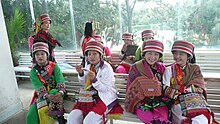Yi (people)
The Yi (own name: ꆈꌠ in official transcription: nuo su , IPA: [ nɔsu ]; Chinese 彝族 , Pinyin Yizu , Yi people), in the West under the obsolete name Lolo known, one of the 56 People's Republic of China recognized Nationalities .
Settlement areas of the Yi
The Yi number 8,714,393 people (2010 census) and are scattered in the southwestern provinces of Sichuan , Yunnan , Guizhou and Guangxi , mainly in rural, mountainous areas.
The autonomous districts and districts of the Yi:
- The circles marked with * are also autonomous districts of other minorities -
- in Sichuan Province :
- Liangshan Autonomous District
- Yi Autonomous Counties in Leshan Prefecture :
- in Yunnan Province
- Chuxiong Autonomous District
- Honghe Autonomous District
- Yi Autonomous Counties in Kunming Prefecture :
- Yi Autonomous Counties in the
- in the Lijiang Prefecture Area : Ninglang Autonomous County *,
- The Yi Autonomous Counties in the Pu'er Prefecture :
- Ning'er *
- Jingdong
- Jinggu *
- Zhenyuan *
- Jiangcheng *
- Yi Autonomous Counties in the Dali Autonomous District of the Bai :
- Weining Autonomous District *
Smaller groups of the Yi live, mostly under the name “Lolo”, “Lolos” also in Vietnam , Laos (approx. 2,000 people each), probably also in Myanmar and Thailand (exact number unknown).
history
The Yi go back to the ancient Qiang, who are also considered the ancestors of the Tibetans , the Naxi and today's Qiang . Originally from south-eastern Tibet, they settled in the 2nd century BC. In the area of today's Kunming and southeast of Xichang . Some of the Yi also emigrated to Thailand . The ethnogenesis of the Yi is complex and draws from several different sources.
language
The roughly 30 different languages spoken among the Yi are predominantly part of the Yi languages , a branch of the Yi-Burmese languages within the Tibeto-Burmese languages . The most important single language is Yi with 4.2 million speakers in the Chinese provinces of Sichuan and Yunnan . In contrast, two small Yi groups of a few hundred people each speak the Kadai languages . In the 13th century its own pictographic script developed. The font originally consisted of around 10,000 characters. In 1956 a Latin script was introduced, but from 1974/1975 a simplified syllabary was used as an experiment. This modern Liangshan-Yi syllabary consists of 1,164 characters. In 1980 it finally achieved official status.
See also: Peoples of Vietnam
literature
- Culture and City History Museum (ed.): China's people of the great cool mountains - The Yi yesterday and today. Duisburg 2006.
- Stevan Harrell (Ed.): Perspectives on the Yi of Southwest China . University of California Press, Berkeley 2001.
- The black Lolo is an experience report from 1962 by Peter Goullart . The work published by List Verlag contains the ethnological description of the very withdrawn people known as the Lolo. It is pointed out that their independent culture was not reshaped by either the Chinese or the Tibetans. Goullart managed to penetrate this area in 1939 and to make friends with a Lolo prince. The book was published in the German translation by Kurt Wagenseil .
Others
The fossil crustacean Yicaris dianensis was named after the Yi .
Web links
- Yi Nationality Literature Online Bibliography (Based on Bibliographies in Chinese by Bamo Qubumo) ( Memento from April 1, 2012 in the Internet Archive )
- The Yi Ethnic Minority on china.org.cn, a website of the Government of the People's Republic of China
- The History of the Yi People ( Memento from March 12, 2013 in the Internet Archive ) on en.chinastoneforest.com
Footnotes
- ↑ Page no longer available , search in web archives:
- ↑ n-tv.de, ancestors of the flying insects - oldest cancer identified , October 31, 2007 ( Memento of August 4, 2012 in the web archive archive.today )


